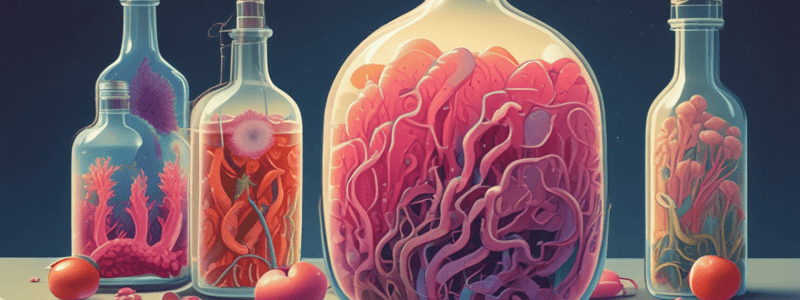Podcast
Questions and Answers
What is the approximate number of yeast cells in one pound of compressed yeast?
What is the approximate number of yeast cells in one pound of compressed yeast?
- 15 trillion (correct)
- 1 trillion
- 5 trillion
- 20 trillion
What is the purpose of amylase in bread baking?
What is the purpose of amylase in bread baking?
- To slow down the fermentation process
- To break down sugar into carbon dioxide
- To enhance the flavor of the bread
- To break down starch into sugar (correct)
What is the process by which yeast cells break down sugars for energy?
What is the process by which yeast cells break down sugars for energy?
- Respiration
- Glycolysis
- Fermentation (correct)
- Photosynthesis
What is the byproduct of fermentation that is responsible for the expansion of dough during baking?
What is the byproduct of fermentation that is responsible for the expansion of dough during baking?
What is the name of the process by which yeast cells break down sugars into simpler molecules?
What is the name of the process by which yeast cells break down sugars into simpler molecules?
What is the term sometimes used to refer to the many enzymes in yeast that take part in the breakdown of sugars?
What is the term sometimes used to refer to the many enzymes in yeast that take part in the breakdown of sugars?
What is the purpose of malted barley flour in bread baking?
What is the purpose of malted barley flour in bread baking?
Who proved that living yeast was necessary for fermentation?
Who proved that living yeast was necessary for fermentation?
At what temperature does yeast fermentation essentially stop?
At what temperature does yeast fermentation essentially stop?
What is the effect of high sugar concentrations on yeast fermentation?
What is the effect of high sugar concentrations on yeast fermentation?
What is the purpose of using a sponge or preferment in rich, sweet doughs?
What is the purpose of using a sponge or preferment in rich, sweet doughs?
What is the effect of salt on yeast fermentation?
What is the effect of salt on yeast fermentation?
What type of sugar is fermented slowly by yeast?
What type of sugar is fermented slowly by yeast?
What is the optimal pH range for yeast fermentation?
What is the optimal pH range for yeast fermentation?
What is the effect of using a large amount of yeast in dough?
What is the effect of using a large amount of yeast in dough?
Why is it best to use a small amount of yeast when using a long fermentation time?
Why is it best to use a small amount of yeast when using a long fermentation time?
What type of yeast is often used in no-time doughs?
What type of yeast is often used in no-time doughs?
What is the effect of antimicrobial agents on yeast fermentation?
What is the effect of antimicrobial agents on yeast fermentation?
What is the primary reason why quick-fermenting yeasts are not desirable in long fermentation times?
What is the primary reason why quick-fermenting yeasts are not desirable in long fermentation times?
What is the term for yeast that grows well in high-sugar environments?
What is the term for yeast that grows well in high-sugar environments?
How long does it take for regular yeast to adapt to a high-sugar environment?
How long does it take for regular yeast to adapt to a high-sugar environment?
What is the term for a naturally fermented sourdough starter?
What is the term for a naturally fermented sourdough starter?
What is the purpose of adding rye flour, onion, or potato to a sourdough starter?
What is the purpose of adding rye flour, onion, or potato to a sourdough starter?
How often does a fresh sourdough starter need to be made?
How often does a fresh sourdough starter need to be made?
What is the main difference between compressed yeast and active dry yeast?
What is the main difference between compressed yeast and active dry yeast?
What is the process by which active dry yeast is dried?
What is the process by which active dry yeast is dried?
What is the percentage of dead yeast cells in active dry yeast?
What is the percentage of dead yeast cells in active dry yeast?
What is the recommended way to use compressed yeast in dough?
What is the recommended way to use compressed yeast in dough?
What is the main reason why active dry yeast is not popular with professional bakers?
What is the main reason why active dry yeast is not popular with professional bakers?
In what type of dough production is the tendency of active dry yeast to slacken dough desirable?
In what type of dough production is the tendency of active dry yeast to slacken dough desirable?
How much water should active dry yeast be dissolved in?
How much water should active dry yeast be dissolved in?
What is the temperature range for initial dough temperatures when using instant yeast?
What is the temperature range for initial dough temperatures when using instant yeast?
What is the advantage of using instant yeast over compressed or active dry yeast?
What is the advantage of using instant yeast over compressed or active dry yeast?
How much instant yeast should be used compared to fresh compressed yeast?
How much instant yeast should be used compared to fresh compressed yeast?
What is the recommended storage method for opened instant yeast?
What is the recommended storage method for opened instant yeast?
What is the shelf life of unopened instant yeast at room temperature?
What is the shelf life of unopened instant yeast at room temperature?
Flashcards are hidden until you start studying
Study Notes
Yeast Fermentation
- Yeast fermentation is a process in which yeast cells break down sugars for energy, producing carbon dioxide and alcohol as byproducts.
- Yeast uses the energy for survival and reproduction.
- The rate of yeast fermentation is affected by several factors, including temperature, amount of salt, amount of sugar, type of sugar, pH of dough, presence of antimicrobial agents, and amount of yeast.
Yeast Cells
- Yeast cells are very small, single-celled microorganisms, with approximately 15 trillion cells in one pound of compressed yeast.
- Yeast cells reproduce by budding, and visible scars from previous buddings can be seen on the yeast cell.
Enzymes and Fermentation
- Yeast can be thought of as tiny enzyme machines, breaking sugars into smaller and simpler molecules with every step.
- Yeast lacks amylase and cannot break down starch into sugar, which is why amylase is an important additive in bread baking.
- The overall process of fermentation involves multiple steps, controlled by separate enzymes, and produces carbon dioxide, alcohol, and small amounts of flavor molecules.
Factors Affecting Yeast Fermentation
- Temperature: Yeast is dormant at 32–34°F (0–1°C), active at 50°F (10°C), and slows down at 120°F (50°C), with an optimal temperature of 78–82°F (25–28°C).
- Amount of salt: Salt retards yeast fermentation, and the optimal amount of salt is 1.8–2.5% (baker's percentage).
- Amount of sugar: Small amounts of sugar (up to 5%) increase yeast activity, while large amounts (above 10%) slow fermentation.
- Type of sugar: Sucrose, glucose, and fructose are fermented rapidly, maltose is fermented slowly, and lactose is not fermented at all.
- pH of dough: The optimal pH for yeast fermentation is an acidic 4 to 6.
- Presence of antimicrobial agents: Certain antimicrobial agents slow or stop yeast fermentation.
- Amount of yeast: The more yeast, the faster the fermentation, but excessive yeast can add an undesirable yeasty flavor and exhaust dough of sugars.
Types of Yeast
- Compressed yeast: Fresh, moist cakes or blocks with 30% yeast and 70% moisture, lasts up to two weeks when stored wrapped in plastic and refrigerated, and three to four months when frozen.
- Active dry yeast: Dried granules with less than 10% moisture, sold in vacuum-packed jars or pouches, and lasts several months at room temperature, longer if frozen or refrigerated.
- Instant yeast: Developed in the 1970s, instant yeast can be added directly to dough without first hydrating in water, and is more vigorous than compressed or active dry yeast.
Sourdough Starters
- Sourdough starters are prepared by mixing flour and water, allowing wild yeast and lactobacilli bacteria to ferment, and can be used to leaven bread.
- Fresh starter does not need to be made for each new day's production, and can be saved for the next day's bread by mixing it with fresh flour and water.
- Some bakeshops pride themselves on the number of years they have continued to bake from their original starter.
Studying That Suits You
Use AI to generate personalized quizzes and flashcards to suit your learning preferences.




